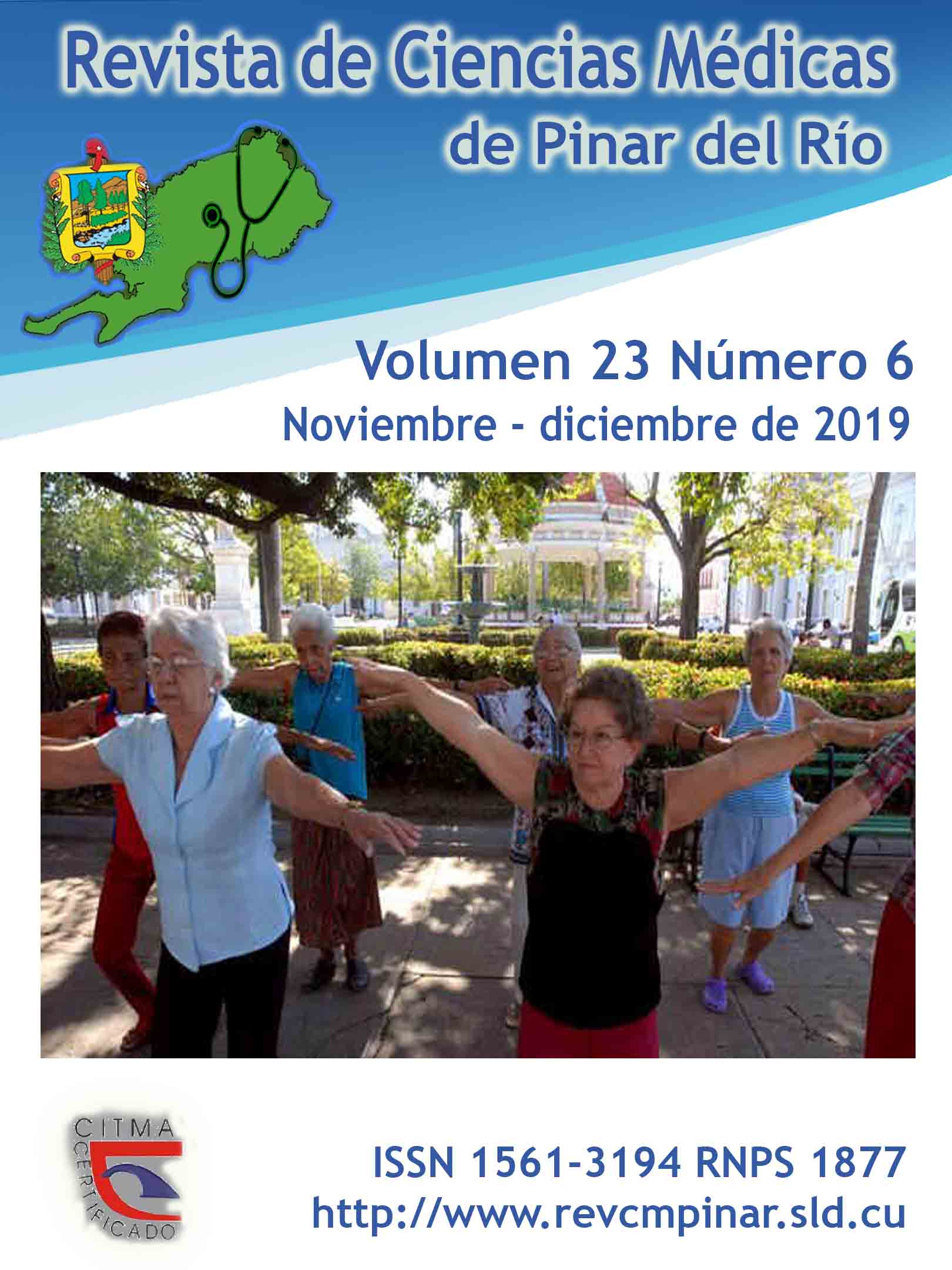Sepsis, direct causes of death and bacterial resistance in an intensive care unit
Keywords:
SEPSIS, CRITICAL CARE, CAUSE OF DEATH, PRODUCTS WITH ANTIMICROBIAL ACTION, SHOCK, SEPTIC.Abstract
I
Introduction: sepsis today represents a worldwide problem, with high incidence and a significant impact on intensive care units, the setting of patients’ care with deteriorated health conditions.
Objective: to evaluate the behavior of sepsis at No-2 Intensive Care Unit, Abel Santamaría Cuadrado General Teaching Hospital, during 2018.
Methods: an observational, descriptive, longitudinal and retrospective study was conducted in relation to the behavior of rate of the general sepsis, direct causes of death and bacterial resistance in the chosen Intensive Care Unit.
Results: the general rate of sepsis in 2018 was 45.2% (the mean), among the direct causes of death were septic shock and Multiple Organ Dysfunction Syndrome (MODS) were present in addition to severe bilateral bronchopneumonia and bacterial resistance confirmed in vitro to some of the antimicrobials that are in use today.
Conclusions: it was confirmed sepsis constituted a common entity and in increasing rate in the service studied.
Downloads
References
1. Pérez BMR. Actualización de la sepsis en adultos. Código de sepsis. Universidad internacional de Andalucía [Internet]. 2015 [citado 20/07/2019]: [Aprox. 52p.]. Disponible en: https://dspace.unia.es/handle/10334/3418
2. Martín Ramirez JF, Domínguez Borgua A, Vázquez Flores AD. Sepsis. Med Int Mex [Internet]. 2014 [citado 20/07/2019]; 30(2): [aprox. 11p.]. Disponible en: https://www.medigraphic.com/pdfs/medintmex/mim-2014/mim142g.pdf
3. Marcia Contrin L, Del Arco Paschoa V, Marinilza Beccaria L, Bernardi Cesarino C, Ajeje Lobo S M. Calidad de vida de sobrevivientes de sepsis grave después del alta hospitalaria. Rev Latino Am. Enfermagem [Internet]. 2013 May – Jun [citado 20/07/2019]; 21(3):[aprox. 8p.]. Disponible en: http://www.scielo.br/pdf/rlae/v21n3/es_0104-1169-rlae-21-03-0795.pdf
4. Anuario Estadístico. Ministerio de Salud Pública. La Habana [Internet]. 2017. Disponible en: http://bvscuba.sld.cu/anuario-estadistico-de-cuba/
5. Rodríguez Martínez HO, Sánchez Lago G. Neumonía asociada a la ventilación mecánica en una unidad de cuidados intensivos. Rev. Ciencias Médicas de Pinar del Río. [Internet]. 2016 Sep-Oct [citado 20/07/2019]; 20(5): [aprox. 4p.]. Disponible en: http://scielo.sld.cu/scielo.php?script=sci_arttext&pid=S1561-31942016000500010
6. Pérez Morales L, Barletta Castillo JE, Quintana Hernández H, Reyes Rodríguez I, Otero Espino N. Estudio clínico, epidemiológico y microbiológico de pacientes con Neumonía asociada a la ventilación mecánica artificial ingresados en salas de cuidados intensivos. Medisur [Internet]. 2012 [citado 20/07/2019]; 10(4): [aprox. 10p.]. Disponible en: http://scielo.sld.cu/scielo.php?script=sci_arttext&pid=S1727-897X2012000400001
7. Objetivos de Trabajo y Criterios de Medida. Ministerio de Salud Pública; 2019.
8. Ortega González LM, Duque Vizcaíno M, Valdés Casanova J, Verdasquera C. Sepsis grave en la unidad de terapia intensiva del Instituto de Medicina Tropical " Pedro Kourí ". Revista cubana de de Salud pública [Internet]. 2018 [citado 20/07/2019]; 44(2): [aprox. 10p.]. Disponible en: http://scielo.sld.cu/scielo.php?script=sci_arttext&pid=S0864-34662018000200213
9. Singer M, Deutschman CS, Warren Seymour C. The Third International Consensus Definitions for Sepsis and Septic Shock (Sepsis-3). JAMA [Internet]. 2016 [citado 20/07/2019]; 315(8): [aprox. 10p.]. Disponible en: https://jamanetwork.com/journals/jama/article-abstract/2492881
10. Gotts JE, Matthay MA. Fisiopatología y tratamiento de la sepsis. BMJ [Internet]. 2016 [citado 20/07/2019]; 353: [aprox. 15p.]. Disponible en: http://clinicainfectologica2hnc.webs.fcm.unc.edu.ar/files/2018/03/Fisiopatolog%C3%ADa-y-tratamiento-de-la-sepsis.pdf
11. Vázquez Grande G, kumar Fuente A. Optimización del tratamiento antimicrobiano de la sepsis y el shock séptico. Semin Respir Crit Care Med [Internet]. 2015 [citado 20/07/2019]; 36(1): [aprox. 10p.]. Disponible en: https://www.intramed.net/contenidover.asp?contenidoid=86738
12. Ygualada Correa Y, Benítez Pérez MO, Victores Moya JA. Correlación clínico patológica en fallecidos del Hospital Universitario Clínico Quirúrgico Cmdte Manuel Fajardo Rivero. Medicent Electron. [Internet]. 2019 Ene-Mar. [citado 20/07/2019]; 23(1): [aprox. 5p.]. Disponible en: http://scielo.sld.cu/scielo.php?script=sci_arttext&pid=S1029-30432019000100009
13. Pérez Verea L, Olivera Reyes Y, Alcalde Mustelier GR. Infecciones Nosocomiales y Resistencia antimicrobiana en la UCI del Hospital J. Albarrán 2015-2016. [Internet]. Convención Internacional de Salud, Cuba Salud; 2018. [citado 20/07/2019]. Disponible en: http://www.convencionsalud2018.sld.cu/index.php/connvencionsalud/2018/paper/download/1439/885.
Published
How to Cite
Issue
Section
License
Authors who have publications with this journal agree to the following terms: Authors will retain their copyrights and grant the journal the right of first publication of their work, which will be publication of their work, which will be simultaneously subject to the Creative Commons Attribution License (CC-BY-NC 4.0) that allows third parties to share the work as long as its author and first publication in this journal are indicated.
Authors may adopt other non-exclusive license agreements for distribution of the published version of the work (e.g.: deposit it in an institutional telematic archive or publish it in a volume). Likewise, and according to the recommendations of the Medical Sciences Editorial (ECIMED), authors must declare in each article their contribution according to the CRediT taxonomy (contributor roles). This taxonomy includes 14 roles, which can be used to represent the tasks typically performed by contributors in scientific academic production. It should be consulted in monograph) whenever initial publication in this journal is indicated. Authors are allowed and encouraged to disseminate their work through the Internet (e.g., in institutional telematic archives or on their web page) before and during the submission process, which may produce interesting exchanges and increase citations of the published work. (See The effect of open access). https://casrai.org/credit/



